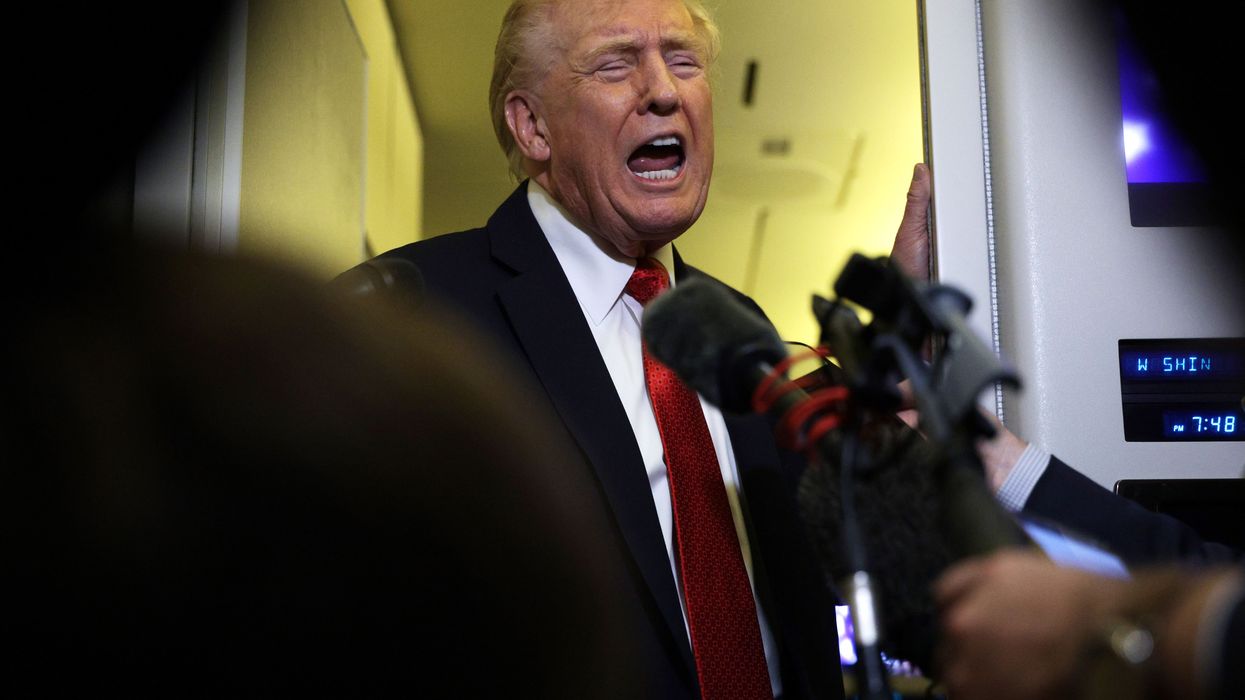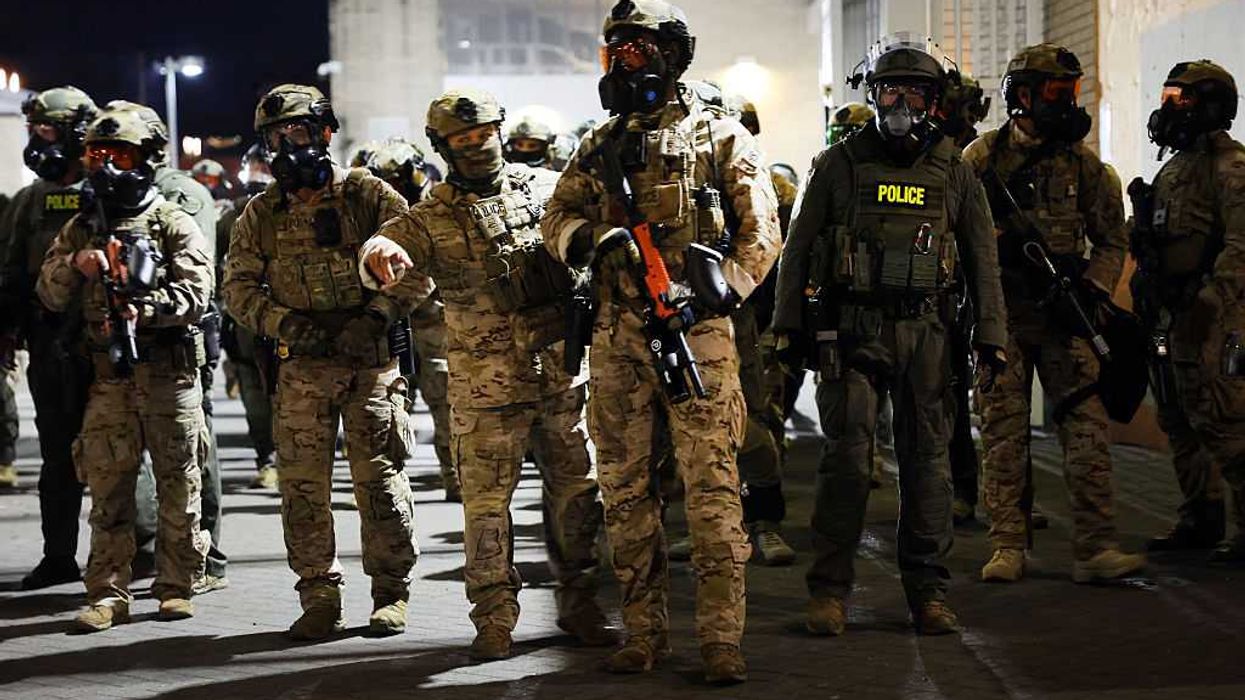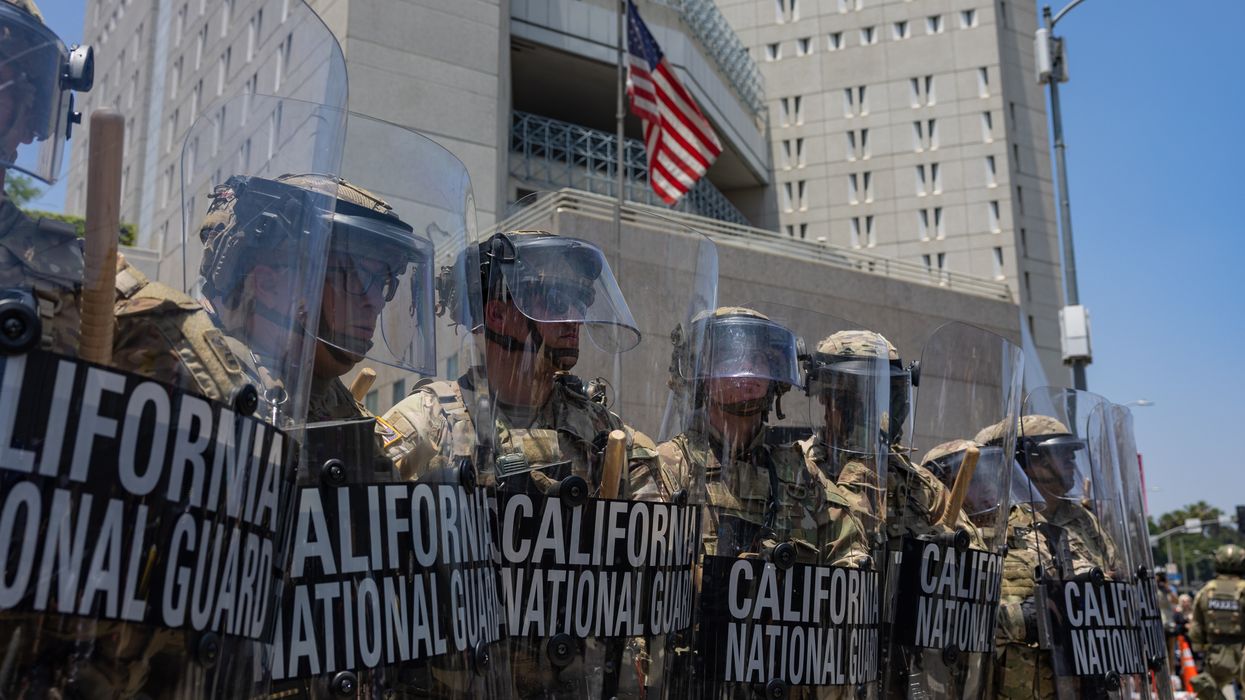Trump Threatens to Invoke Insurrection Act, Take 'Unquestioned Power' Following No Kings Protests
Trump claimed that if he invokes the Insurrection Act, "there are no more court cases, there is no more anything."
While the nation was fixated on President Donald Trump’s deranged social media antics in response to this weekend’s "No Kings" protests, he managed to slip under the radar with some ominous threats to substantially expand his power.
The president generated bewilderment and outrage when, in response to the mass mobilization of more than 7 million Americans against his abuses of power, he posted an artificially-generated video of himself wearing a crown and flying a fighter jet emblazoned with “King Trump” that dumped what appeared to be a pile of excrement upon demonstrators in the middle of Times Square.
The public was understandably preoccupied with the president of the United States posting a video of himself “literally dumping shit on America,” which Ron Filipkowski of MeidasTouch called “metaphorically the most accurate piece of propaganda he’s put out this year.”
But it served as a useful distraction as Trump implied that he may use these protests as a pretext to invoke the Insurrection Act, which he incorrectly suggested gives him “unquestioned power.”
“Don’t forget, I can use the Insurrection Act,” Trump said in a Fox News interview Sunday morning. “Fifty percent of the presidents almost have used that. And that’s unquestioned power. I choose not to.”
“I’d rather do this,” he said, referring to his deployment of the National Guard to American cities, including Chicago, Portland, and now San Francisco, which he announced as his next target last week. “But I’m met constantly by fake politicians, politicians that think that they—you know, it’s not a part of the radical left movement to have safety. These cities have to be safe.”
The Insurrection Act of 1807 allows presidents to direct federal troops to enforce US law in cases of extreme emergency, including rebellions against the federal government, beyond the reach of traditional law enforcement. Contrary to Trump’s claim, it has only been invoked by about a quarter of US presidents.
The last president to invoke the act was George H.W. Bush, in response to the riots in Los Angeles following the acquittal of the police officers who brutalized Rodney King in 1992. Other presidents invoked it during times of extreme upheaval or war, including President Abraham Lincoln, who used it during the Civil War, and Ulysses S. Grant, who used it to suppress terrorism against newly freed Black Americans by the Ku Klux Klan across the South.
It has not historically been used to put down peaceful protests, like this past weekend’s No Kings marches, which frequently emphasize their commitment to nonviolence.
It is unclear what precisely Trump referred to when he said “that’s unquestioned power.” He may have meant that he has unquestioned power to invoke the Insurrection Act, which is also not true.
The law gives the president the power to invoke it in response to “insurrection, domestic violence, unlawful combination, or conspiracy,” which has made it “impracticable to enforce the laws... by the ordinary course of judicial proceedings.”
Though the Supreme Court has largely granted the president the authority to determine what forms of unrest may meet these criteria, Joseph Nunn, a lawyer at the Brennan Center for Justice, explained earlier this year that "there are exceptions to the general rule that courts can’t review a president’s decision to deploy" forces:
The Supreme Court has suggested that courts may step in if the president acts in bad faith, exceeds "a permitted range of honest judgment," makes an obvious mistake, or acts in a way manifestly unauthorized by law.
Even in cases where the courts will not second-guess the decision to deploy troops, the Supreme Court clarified in Sterling v. Constantin (1932) that courts may still review the lawfulness of the military’s actions once deployed. In other words, federal troops are not free to violate other laws or trample onconstitutional rights just because the president has invoked the Insurrection Act.
Comments made by Trump aboard Air Force One later on Sunday suggest a different meaning to his claim of “unquestioned power,” that he was not referring to his ability to invoke the act, but rather saying it gives him authority to act unilaterally without any intervention from the courts.
“Everybody agrees you’re allowed to use [the Insurrection Act], and there are no more court cases, there is no more anything. We’re trying to do it in a nicer manner, but we can always use the Insurrection Act,” he continued. “We wanted to go this route, but we get sued every time you look at somebody, you look at somebody the wrong way, and you end up getting sued. We just want no crime.”
Trump has indeed been sued over his deployment of federal troops to American cities, including in Portland, where a judge ruled earlier this month that his claim that the city was “war-ravaged” was “untethered to facts,” as the protests there against US Immigration and Customs Enforcement (ICE) have been overwhelmingly peaceful.
It was also unclear what Trump meant when he said that if he invokes the Insurrection Act, “there are no more court cases, there is no more anything.” The comment seemed to imply that he believes that the Insurrection Act is tantamount to martial law, where the normal forms of due process do not apply, and the courts have no recourse to intervene against abuses of power.
Stephen Miller, Trump’s deputy White House chief of staff, implied a similar unchallenged power earlier this month when he asserted that Trump has “plenary,” meaning practically limitless, “authority” to use the military on US soil, however he sees fit. Miller earlier this year also suggested suspending the writ of habeas corpus, the right to challenge unlawful detention, for immigrants.
Trump previously discussed invoking martial law with his advisers in 2020 in an effort to hold onto power following his election loss and later suggested that the supposed “fraud” in his election loss “allows for the termination of all rules, regulations, and articles, even those found in the Constitution.”
But as Andy Craig, a fellow at the Institute for Humane Studies, explains, even if Trump invoked the Insurrection Act, which he predicted, “is likelier than not,” it doesn’t give him the power to suspend the Constitution, at least not legally.
“None of this is true,” Craig said. “The Insurrection Act is not a declaration of martial law. It doesn’t close the courts. It doesn’t suspend habeas corpus. It means you can use the military to enforce federal laws, but the laws themselves remain the same.”
“There are lots of disasters waiting to happen in how much we have wired up to pure presidential power,” he continued. “But one thing we don’t have is some state-of-exception button the president can push and instantly become an absolute dictator. That’s not a thing in American law. No emergency power encompasses it.”


